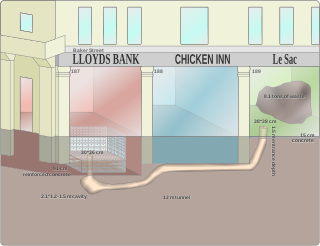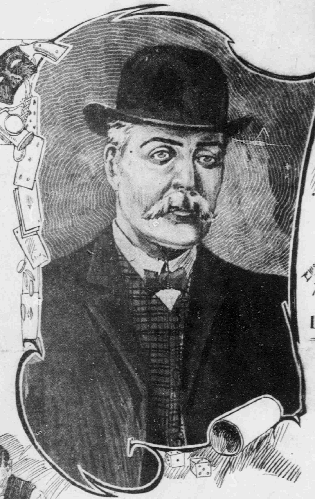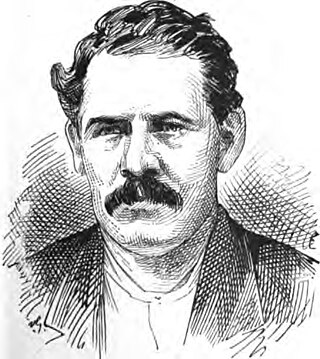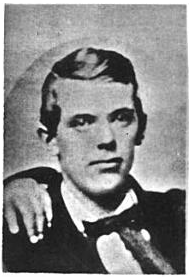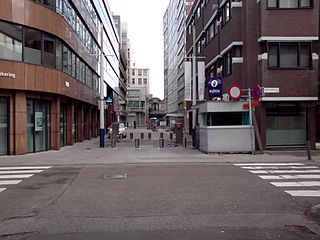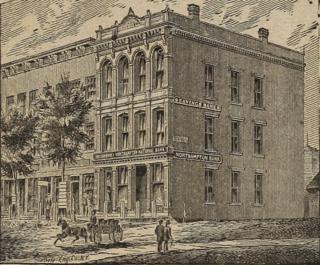Background
The Ocean National Bank was located in Manhattan, New York City, on the corner of Greenwich Street and Fulton Street. [1] It was located on the first of six stories of a brownstone building. [2] At the time of the robbery, the offices included a large business room, the president's private room, and the vault. [3] The vault was made up of three compartments, each with their own door. The outside wall was made up of granite, which was lined on both sides by heavy plates of boiler iron. The first door was held together tightly by bolts and a combination lock. The second door was also made of iron and had a combination lock. The keys to this door hung on itself, meaning it could have been easily unlocked once the first door was bypassed. The third door was an inch-and-one-quarter iron, and had a combination Butterworth No. 3 lock. Inside the inner vault, there were two safes. [4]
George Leonidas Leslie moved from Cincinnati, Ohio, to New York City earlier in 1869. [5] Once there, he met Fredericka "Marm" Mandelbaum. [6] Leslie promised to Mandelbaum to pull off the highest-paying criminal heist in history. [7] Mandelbaum organized a gang to rob the Ocean National Bank, and put him in charge. [8] The robbery would essentially function as Leslie's initiation and trial run for the city's crime world. [9] Leslie had developed an object called "the little joker" which could crack a safe's combination. [10]
Before the robbery could take place, Mandelbaum had to get revenge with Black Lena, a woman whom Leslie was having an affair with, and who joined Mandelbaum's criminal rival Johnny Walsh. Her association with Leslie was the last straw to Mandelbaum. Mandelbaum got her associate, pickpocket [11] Johnny Irving to steal an emerald ring from one of Black Lena's high society guests. Mandelbaum then sent the ring to Lena as a pretend gift from Leslie. Lena displayed the ring at her next dinner party, which was attended by the woman who originally wore the ring. The woman informed her husband, a New Jersey district court judge, who called in Pinkerton agents to investigate. Pinkerton agents and police raided Lena's home in Hackensack and found plenty of stolen property. Mandelbaum then felt that Leslie could focus on the Ocean National Bank robbery. [12]
Planning
Mandelbaum spent $3,000 on the robbery's planning. Planning for the heist took three months. [7] Leslie's gang included Billy Porter, Gilbert Yost, "Jimmy" Hope, Johnny Dobbs, Johnny Irving, John "Red" Leary, Thomas "Shang" Draper. [1] Leslie planned the robbery with more precision than any other bank robbery before him. [9] Draper didn't like the idea of a "tenderfoot" (or beginner) heading a robbery, but Mandelbaum insisted and said he wouldn't be involved if he didn't take orders from Leslie. [8] Draper was sure that Leslie would fail miserably, and instructed Leary to "take care of" Leslie if he did something stupid. Leary accepted, but was lying, as he was sure to follow Leslie's every order at Mandelbaum's behest. [11] Draper and others didn't like the length of the planning, as they wanted to quickly break in and blow up the safe. [7]
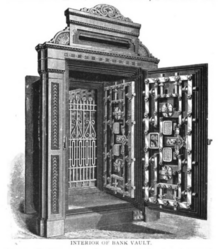
Leslie deposited a large sum into Ocean National Bank, and visited it multiple times under the guise of a depositor. These visits gave him valuable information. [9] Leslie had dinner with the bank's officials, including the president, and he asked which company had made the safe they used. He wanted to make sure it was secure, and would know if it was secure based on his experience as an architect. He received the name of the company, and met the locksmith that made the safe. The locksmith said that the safe was "impenetrable". Leslie used the info he gained talking to the locksmith to make adjustments to the "little joke, accommodating the device to the size and shape of the safe's dial. [2] He eventually knew every square inch of the building, [13] and made blueprints of the bank floor. [2] Mandelbaum provided the burglars with tools, drawing up her own blueprints, and using one of her empty warehouses to construct identical copy of one of the bank's rooms. [9] The replica was based on the blueprints, [2] which he made the gang study. [9] At the warehouse, the gang rehearsed the exact processes and timing of the robbery multiple times, down to split-seconds. He would throw in alternative scenarios to the practicing, such as having them perform in the dark, in case the lights were off. [9] A smaller version of the safe the bank used was bought and placed in the replica bank, based on Leslie's meeting with the locksmith. [14]
Leslie convinced the bank president to hire Johnny Irving as a cleaner at the bank after hours. [11] Prior to the robbery, he took his money out of the bank. [9] He also asked Mandelbaum for $1,000 to rent an office basement located directly under the bank vault and leased by William Kell. [9] [15] Hope put on a fake mustache and wig and went to Kell. [15] He said that he represented the insurance agency Lewis R. Cole & Co., which were agents of New York's Chicago Insurance Company and had credentials from Superintendent Barnes of the Insurance Department. [16] He paid for the space in advance. A desk, chair, and cabinet were delivered to the basement. The cabinet contained burglar tools such as saws. During the weekend, when the robbery was supposed to take place, Irving wouldn't be working, so Leslie decided to drill a hole in the ceiling of the basement, giving them access to the vault. [15] Leslie made everyone wear fake beards for the job; he got the beards from the dressing room of the Grand Opera House, where he was a frequent visitor. [8]




